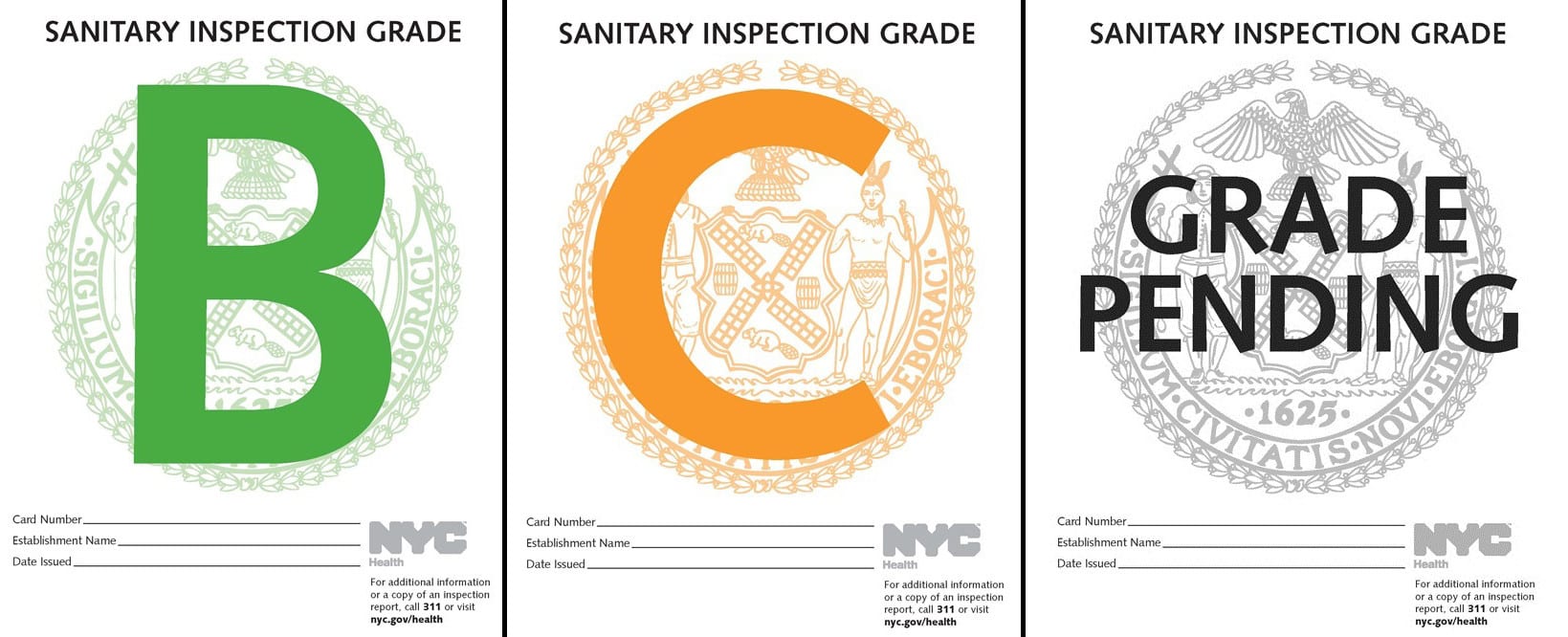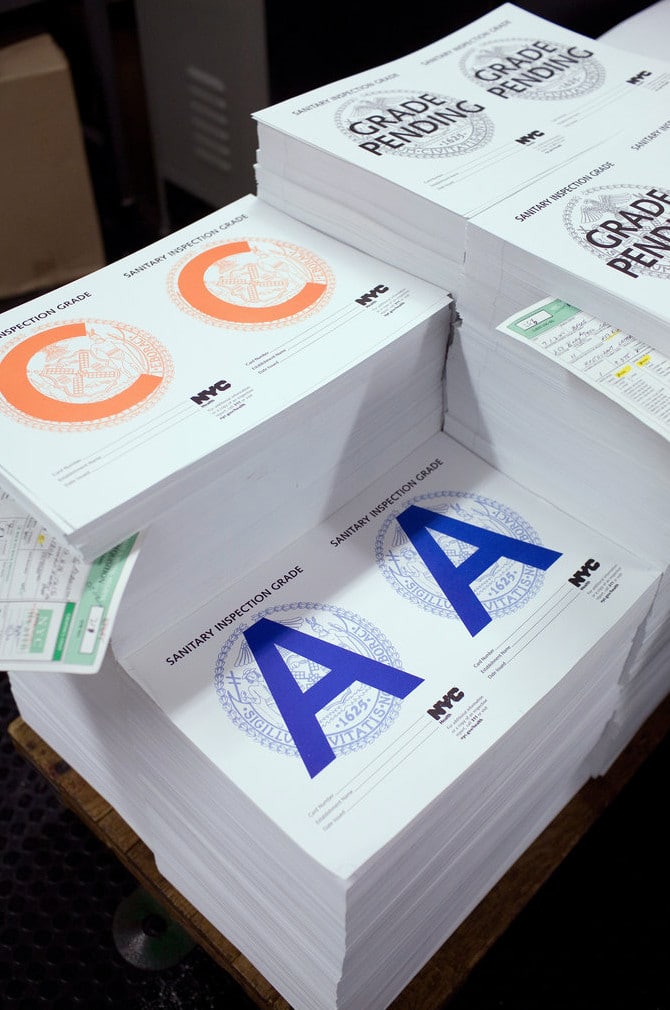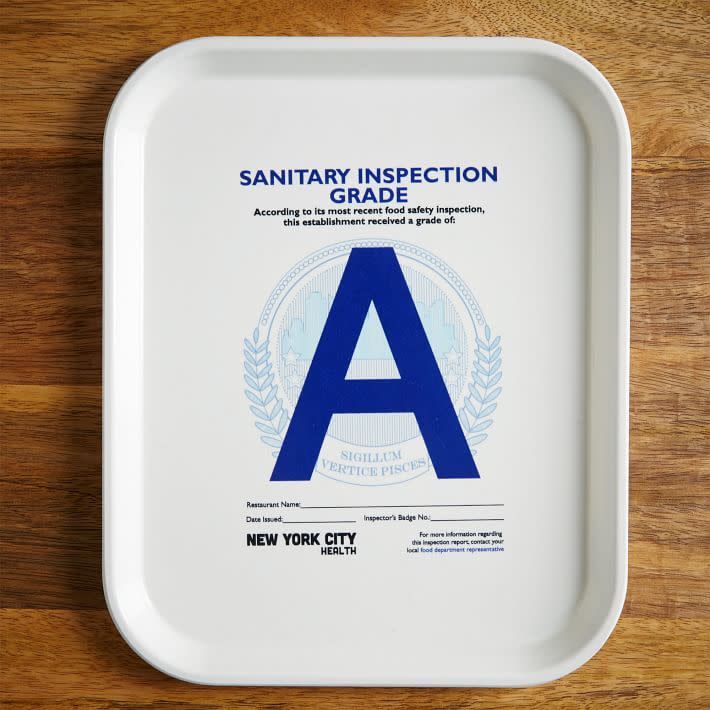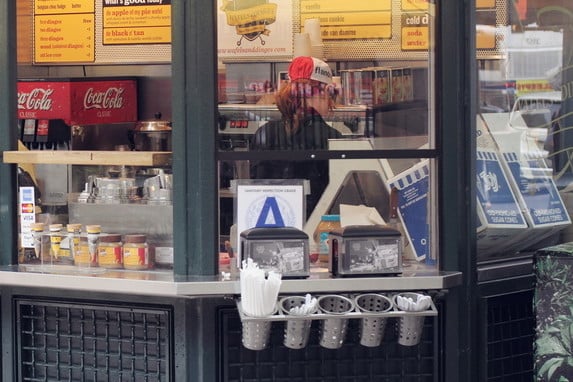Each of New York City’s 24,000 restaurants has a letter grade posted in the window but in big cities, we rarely stop to think about how the signs, systems, and processes that get us through our daily lives came into existence. Who was your office building’s architect? Who curated the public art in your local park? And who designed the A, B and C emblems in every single restaurant window from Harlem to Tribeca?
All over the world, restaurant grading schemes help diners determine whether or not a food service environment is keeping up with health codes and regulations. Health inspectors tour food service areas throughout a restaurant, assigning points as demerits based on the severity of a health code infraction. Everything from food temperatures to storage rooms, bathroom size to hallway width is subject to scrutiny. New York City restaurants (and bars and cafes) are then required to display the grades they earn, regardless of whether or not they agree.
Ubiquitous as the grades are, when the NYC Health Department first commissioned the project from design agency Two Twelve in 2010, it was passed down to a single intern. Graphic designer Jose Torres hadn’t yet graduated from college when he completed designs for the NYC restaurant grading system. Torres grew up surrounded by artists and turned to graphic design during high school with the hopes of finding a way to make both money and art. While pursuing his graphic design degree at the Fashion Institute of Technology, Torres discovered he needed an internship credit to graduate, and ended up on team Two Twelve.
The way he tells it, Torres was in the right place at the right time. Since his internship days, his design career has led to a career as a designer for Macy’s, including the 34th Street window team. We caught up with Torres to talk about the shocking magnitude of his “little” internship project, graphic design as the perfect combination of art and paid work, and the power of committing to your craft.

Format: Hi Jose. How did the restaurant grading project land on your desk as an intern?
Jose Torres: At the time, the New York City Health Department was having issues with a lot of people getting sick. Simple as it seems, you couldn’t really tell if a restaurant was clean or not. It was presented to me as ‘Oh, here’s this little thing.’ The head of the design group and I met with the health department to discuss what they were looking for, their overall needs. I worked with typography, overall layout, color selection, everything. It was just me and this design group leader, but it was me mostly. She didn’t have anybody else working on the project, because it was just the card design and that was it. There were bigger projects going on at the time, so I think it was kind of low on their radar.
When you were working on it as an intern, did you realize how huge and recognizable the project would end up being around New York?
Not at all, I had no clue. I kind of knew the scope—they had said ‘Oh it’s going to be in all the restaurants,’ but I didn’t know if it would be mandatory or how quickly it was going to take off. I finished in May of 2010 and they started production in July. Between that time, I graduated, finished my thesis, had to find an apartment within two weeks, was trying to find a job—all these things were going on. I totally forgot about that project.

Once I had settled down in Bushwick, my aunt called me saying, ‘Your work is on TV.’ I was like, ‘What work? What are you talking about?’ Once I figured out what she meant, I didn’t even believe her. I googled it and the New York Times article popped up—I was floored. The part that got me was in the photo, it’s stacks and stacks of these cards that I made. I’m a visual person, I have to see it. That’s when it hit me, this is really going to be out there.
Now that you’ve been living in NYC for years, what is it like for you to see the cards in every restaurant window everywhere you go?
Even now, I’m kind of in awe. Sometimes I see some really nice restaurants have framed them. I’ve seen trays at Fishs Eddy based off of the cards, based off of what I had done. That was crazy to me, that it was becoming this iconic pop culture phenomenon. The fact that they actually made a product from a design of mine—I love it.
Would you say that restaurant grades impact your decision whether or not to eat somewhere?
They do. There was this one place I was going to religiously, and they got a C when the system came out. I was kind of torn because obviously this is not a good sign, but the food is so good. Ultimately I made the right choice because I think I did get sick one time. The thing is, a lot of restaurants have an A. If you walk two steps down from your spot with a C or a Grade Pending, you’re going to find an A.
Since that internship, you’ve gone on to work in window design and now you’re back in graphic design. You’re also a fine artist—what role do art and design play in your life today?
Art got me through a lot of tough times, and I’ve found a way to live off of it in more ways than one. I’ll say this, I came from nothing. I never pictured myself in New York City doing the things that I’m doing now or the things that I have done. I was in foster care—to anybody that’s in the system, there’s more out there. You just have to be committed.


Health grade trays by Fishs Eddy
Header image by Melissa Contreras












